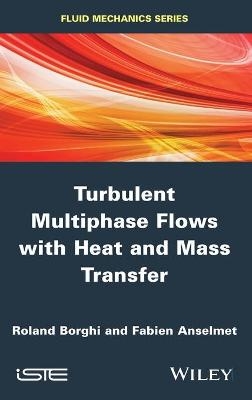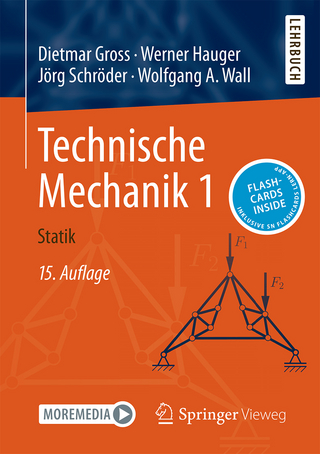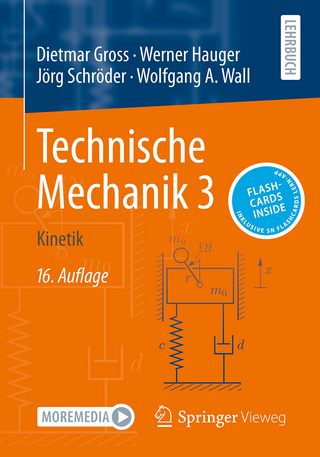
Turbulent Multiphase Flows with Heat and Mass Transfer
ISTE Ltd and John Wiley & Sons Inc (Verlag)
9781848216174 (ISBN)
Thermal engineering and nuclear reactors; the extraction and transport of petroleum products; diesel and rocket engines; chemical engineering reactors and fluidized beds; smoke or aerosol dispersion; landslides and avalanches − the modeling of multiphase flows with heat and mass transfer for all these situations can be developed following a common methodology. This book is devoted to the description of the mathematical bases of how to incorporate adequate physical ingredients in agreement with known experimental facts and how to make the model evolve according to the required complexity.
Roland Borghi is Professor Emeritus at Ecole Centrale Marseille in France and works as a consultant in the space, petrol and automobile sectors. His research activities cover fluid mechanics, combustion and flames, and multi-phase and granular flows. He was a member of the CNRS scientific committee and a laureate of the French Academy of Science. Fabien Anselmet is Professor at Ecole Centrale Marseille in France. His research activities focus on the turbulence of fluids and its varied applications in industry and in fields linked to the environment.
Acknowledgments xi
Introduction xiii
Part 1. Approach and General Equations 1
Chapter 1. Towards a Unified Description of Multiphase Flows 3
1.1. Continuous approach and kinetic approach 3
1.2. Eulerian–Lagrangian and Eulerian formulations 7
Chapter 2. Instant Equations for a Piecewise Continuous Medium 9
2.1. Integral and differential forms of balance equations 10
2.2. Phase mass balance equations in a piecewise continuous medium 13
2.3. Momentum balances 17
2.4. Energy balances 21
2.5. Position and interface area balance equations 23
2.6. Extension for a fluid phase that is a mixture 25
2.7. Completing the description of the medium 27
Chapter 3. Description of a “Mean Multiphase Medium” 29
3.1. The need for a mean description 29
3.2. How are mean values defined? 31
3.2.1. Temporal average 31
3.2.2. Volumetric average 32
3.2.3. Statistical average 34
3.2.4. Filtered average 35
3.3. Which average to choose, according to their advantages and disadvantages? 37
Chapter 4. Equations for the Mean Continuous Medium 39
4.1. Global balance equations for the mean medium 39
4.1.1. Total mass 39
4.1.2. Total momentum 40
4.1.3. Total energy 41
4.2. Balance equations for the phases of a mean medium 42
4.2.1. Phase mass 43
4.2.2. Phase momentum 44
4.2.3. Energies of each phase 47
4.2.4. Phase volume 49
4.3. Complete representation of the mean medium 49
4.3.1. Global representation 50
4.3.2. Multifluid representation 51
4.4. Mean equations of state 55
4.5. Extensions 58
4.5.1. Extension when a fluid phase is a mixture 58
4.5.2. Extension for dispersed media 59
4.6. Boundary conditions 61
Part 2. Modeling: A Single Approach Adaptable To Multiple Applications 67
Chapter 5. The Modeling of Interphase Exchanges 69
5.1. General methodology 69
5.2. Interface between phases and its mean area per unit of volume 71
5.2.1. Case of a suspension of liquid or solid particles 71
5.2.2. Case of a medium containing parcels of variable shapes and sizes 72
5.2.3. Case of a suspension of particles of constant and known sizes 74
5.3. Forces of contact and friction between phases 75
5.3.1. Pressure forces on spherical particles in a non-viscous flow 76
5.3.2. Friction on solid particles in steady flow 80
5.3.3. Slightly curved liquid–gas interfaces 87
5.3.4. Drops or bubbles 93
5.4. Heat transfers at the surface of a particle, without mass exchange 96
5.5. Heat and mass transfers during boiling 99
5.5.1. Slightly curved liquid–gas interfaces 99
5.5.2. Bubbles 105
5.6. Mass and heat exchanges by vaporization 107
5.6.1. Mass transfer by evaporation at a flat interface 107
5.6.2. Evaporation of a drop 113
5.6.3. Combustion of a drop 117
Chapter 6. Modeling Turbulent Dispersion Fluxes 119
6.1. Global modeling 119
6.1.1. General information 119
6.1.2. Kinetic energy of the “global fluctuations” 123
6.1.3. Modeling the kinetic energy of the fluctuations 128
6.1.4. Length scales for fluctuations and time scale for the dissipation of kinetic energy of fluctuations 132
6.1.5. Further studies on the dispersion flux of a phase 137
6.2. “Multifluid” modeling 147
6.2.1. The kinetic energy of the fluctuations in each phase 149
6.2.2. Modeling the balance equations of the kinetic energies of turbulence 152
6.2.3. The modeling of time or spatial scales 158
6.2.4. Modeling of the Reynolds tensor for every phase 162
Chapter 7. Modeling the Mean Gas–Liquid Interface Area per Unit Volume 165
7.1. Introduction 165
7.2. Initial equation for the mean interface area per unit volume 166
7.3. Model of the mean interface area during the “atomization” of a liquid jet 168
7.4. Effects of vaporization on the interface area 172
Chapter 8. “Large Eddy Simulation” Style Models 175
8.1. Introduction 175
8.2. Filtered equations and the nature of the models to be provided 177
8.3. Classic LES modeling for SGS additional fluxes 181
8.3.1. Reminder of LES in single-phase, constant density turbulent flows 181
8.3.2. Toward an extension for multiphase flows 183
8.4. Subgrid modeling of the interface area per unit volume 185
8.5. Partially Integrated Turbulence Modeling 188
Chapter 9. Contribution of Thermodynamics of Irreversible Processes 191
9.1. Global two-phase medium models 192
9.1.1. Entropy of a mean two-phase medium using the Prandtl model 194
9.1.2. Entropy for the k–ε model, in a medium with a variable density 200
9.2. Contribution of thermodynamics to multifluid models 206
Chapter 10. Experimental Methods 213
10.1. Introduction 213
10.2. Intrusive methods 214
10.2.1. Pitot tubes 215
10.2.2. Hot films 216
10.2.3. Optical needle probes (single probes, bi-probes and quadri-probes) 219
10.2.4. Wire networks 223
10.3. Non-intrusive methods 224
10.3.1. Particle image velocimetry (PIV) 225
10.3.2. Droplet tracking velocimetry 230
10.3.3. Laser Doppler anemometry (LDA) 234
10.3.4. Phase Doppler anemometry (PDA) 237
10.3.5. Ultrasonic Doppler Anemometry 241
10.3.6. Densimetry by attenuation of gamma, X-ray or neutron radiation 243
10.4. Advanced optical methods 245
10.4.1. Laser induced fluorescence 245
10.4.2. Interferometric methods (digital inline holography, Fourier interferometric imaging, ILIDS/IPI, rainbow) 252
Chapter 11. Some Experimental Results Pertaining to Multiphase Flow Properties that Are Still Little Understood 265
11.1. Atomization/fragmentation of liquid jets 265
11.2. Isolated bubbles, bubbles in swarm and their effects on carrier fluid 274
11.3. Boiling crisis 285
Part 3. From Fluidized Beds To Granular Media 297
Chapter 12. Fluidized Beds 299
12.1. Introduction 299
12.1.1. Classification of different fluidization regimes 299
12.1.2. Minimum fluidization and bubbling velocities 304
12.2. Complete models for the dynamics of fluidized beds 306
12.2.1. Bubbling fluidization regime 307
12.2.2. Turbulent fluidization regime 315
12.3. Global models for chemical conversion in fluidized beds 321
12.3.1. Bubbling regime fluidizations 321
12.3.2. Fast fluidization regime 324
12.3.3. Turbulent fluidization regime 325
12.4. Global models for heat transfers in fluidized beds 328
12.4.1. Bubbling fluidization regime 328
12.4.2. Fast fluidization regimes – circulating beds 331
12.5. Conclusion 334
Chapter 13. Generalizations for Granular Media 335
13.1. Introduction 335
13.2. Balance equations for mean granular media 336
13.3. Necessary closure approximations 342
13.4. Some already proposed methods 345
Chapter 14. Modeling of Cauchy Tensor of Sliding Contacts 349
14.1. Hypotheses and basic equations 349
14.2. Unclosed balance equation for Cauchy tensor of sliding contact 351
14.3. Closure approximations for irreversible terms 358
Chapter 15. Modeling the Kinetic Cauchy Stress Tensor 363
15.1. Prandtl–Bagnold modeling 364
15.2. K-lt or “turbulent granular gas” modeling 366
15.3. Toward a general model for all regimes 371
15.4. Boundary conditions at walls 373
Part 4. Studying Fluctuations and Probability Densities 377
Chapter 16. Fluctuations of the Gas Phase in Reactive Two-Phase Media 379
16.1. Specificities of reactive two-phase media 379
16.2. Probability density of composition fluctuations of the gas phase 380
16.2.1. Instant basic equations of the gas medium 382
16.2.2. PDF equation 385
16.3. Modeling the terms due to exchanges between phases 390
16.3.1. Total mass exchange 390
16.3.2. Mass exchange for species 392
16.3.3. Heat exchange 393
16.4. Modeling micromixing and turbulent dispersion 395
16.4.1. The “micromixing” term in PDF equations 395
16.4.2. Turbulent diffusion terms in PDF equations 396
16.5. Practical use of PDF equations 397
Chapter 17. Temperature Fluctuations in Condensed Phases 399
17.1. Problems 399
17.2. Instantaneous equation for the temperature of the liquid phase 401
17.3. Equation for the PDF of the temperature of the liquid 403
17.4. Closure of the equation of the temperature PDF 405
Chapter 18. Study of the PDF for Velocity Fluctuations and Sizes of Parcels 409
18.1. Phase velocity PDF equation 410
18.2. Modeling the exchanges between phases and the internal interactions 415
18.2.1. Terms of exchanges between phases 415
18.2.2. Internal dissipation and production of fluctuations 418
18.3. Practical calculation of PDF 419
18.4. The study of the sizes of the dispersed phase parcels 420
18.5. Eulerian–Lagrangian simulation of dispersed media 423
18.5.1. Lagrangian equations of the parcels 423
18.5.2. Stochastic simulations 426
Bibliography 431
Index 443
| Verlagsort | London |
|---|---|
| Sprache | englisch |
| Maße | 160 x 241 mm |
| Gewicht | 848 g |
| Themenwelt | Naturwissenschaften ► Physik / Astronomie ► Mechanik |
| Technik ► Maschinenbau | |
| ISBN-13 | 9781848216174 / 9781848216174 |
| Zustand | Neuware |
| Informationen gemäß Produktsicherheitsverordnung (GPSR) | |
| Haben Sie eine Frage zum Produkt? |
aus dem Bereich


